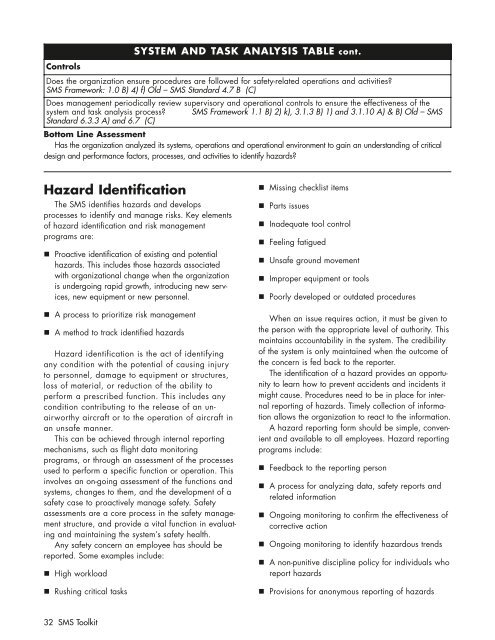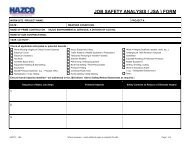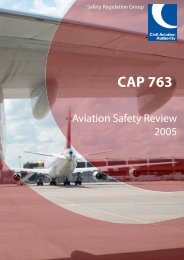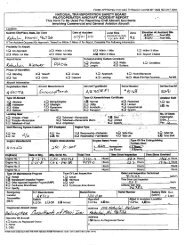International Helicopter Safety Team Safety Management System Toolkit
IHST - Safety Management Toolkit - Skybrary
IHST - Safety Management Toolkit - Skybrary
- No tags were found...
Create successful ePaper yourself
Turn your PDF publications into a flip-book with our unique Google optimized e-Paper software.
SYSTEM AND TASK ANALYSIS TABLE cont.<br />
Controls<br />
Does the organization ensure procedures are followed for safety-related operations and activities?<br />
SMS Framework: 1.0 B) 4) f) Old – SMS Standard 4.7 B (C)<br />
Does management periodically review supervisory and operational controls to ensure the effectiveness of the<br />
system and task analysis process? SMS Framework 1.1 B) 2) k), 3.1.3 B) 1) and 3.1.10 A) & B) Old – SMS<br />
Standard 6.3.3 A) and 6.7 (C)<br />
Bottom Line Assessment<br />
Has the organization analyzed its systems, operations and operational environment to gain an understanding of critical<br />
design and performance factors, processes, and activities to identify hazards?<br />
Hazard Identification<br />
The SMS identifies hazards and develops<br />
processes to identify and manage risks. Key elements<br />
of hazard identification and risk management<br />
programs are:<br />
Proactive identification of existing and potential<br />
hazards. This includes those hazards associated<br />
with organizational change when the organization<br />
is undergoing rapid growth, introducing new services,<br />
new equipment or new personnel.<br />
A process to prioritize risk management<br />
A method to track identified hazards<br />
Hazard identification is the act of identifying<br />
any condition with the potential of causing injury<br />
to personnel, damage to equipment or structures,<br />
loss of material, or reduction of the ability to<br />
perform a prescribed function. This includes any<br />
condition contributing to the release of an unairworthy<br />
aircraft or to the operation of aircraft in<br />
an unsafe manner.<br />
This can be achieved through internal reporting<br />
mechanisms, such as flight data monitoring<br />
programs, or through an assessment of the processes<br />
used to perform a specific function or operation. This<br />
involves an on-going assessment of the functions and<br />
systems, changes to them, and the development of a<br />
safety case to proactively manage safety. <strong>Safety</strong><br />
assessments are a core process in the safety management<br />
structure, and provide a vital function in evaluating<br />
and maintaining the system’s safety health.<br />
Any safety concern an employee has should be<br />
reported. Some examples include:<br />
High workload<br />
Rushing critical tasks<br />
Missing checklist items<br />
Parts issues<br />
Inadequate tool control<br />
Feeling fatigued<br />
Unsafe ground movement<br />
Improper equipment or tools<br />
Poorly developed or outdated procedures<br />
When an issue requires action, it must be given to<br />
the person with the appropriate level of authority. This<br />
maintains accountability in the system. The credibility<br />
of the system is only maintained when the outcome of<br />
the concern is fed back to the reporter.<br />
The identification of a hazard provides an opportunity<br />
to learn how to prevent accidents and incidents it<br />
might cause. Procedures need to be in place for internal<br />
reporting of hazards. Timely collection of information<br />
allows the organization to react to the information.<br />
A hazard reporting form should be simple, convenient<br />
and available to all employees. Hazard reporting<br />
programs include:<br />
Feedback to the reporting person<br />
A process for analyzing data, safety reports and<br />
related information<br />
Ongoing monitoring to confirm the effectiveness of<br />
corrective action<br />
Ongoing monitoring to identify hazardous trends<br />
A non-punitive discipline policy for individuals who<br />
report hazards<br />
Provisions for anonymous reporting of hazards<br />
32 SMS <strong>Toolkit</strong>







